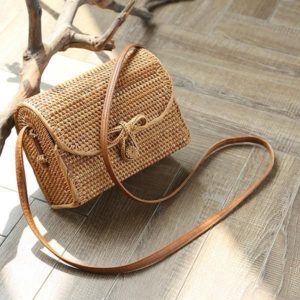 The history of the appearance of bags goes back more than five thousand years. It is believed that first the first “knots” appeared, the so-called bags tied to sticks. Then there were “omoniers” - bags that women wore under their skirts and men wore on their belts. In them, women kept coins, combs, a mirror and other little things necessary for a lady.
The history of the appearance of bags goes back more than five thousand years. It is believed that first the first “knots” appeared, the so-called bags tied to sticks. Then there were “omoniers” - bags that women wore under their skirts and men wore on their belts. In them, women kept coins, combs, a mirror and other little things necessary for a lady.
Next came reticules, which were decorated with beads, glass beads, and embroidered with multi-colored and gold threads, as well as lace and tassels. They could be knitted or wicker. Reticules were no longer hidden, they were actively demonstrated as decoration and an element of the toilet.
Over time, the accessory began to change, and only at the beginning of the 19th century did bags acquire their usual appearance. They varied in size, shades, and shape. Some had a long strap, others a short one. Some bags were closed with rivets, others with zippers. Some had a strap or chain. Finding the right bag is no longer as problematic as it used to be.
How the bag came to be
 Modern bags appeared during the French Revolution with the birth of new fashion. Now you could not hide your bags under your skirt, but boldly carry them in your hands or on your shoulder, thereby demonstrating their beauty to others. The handbag replaced reticules, coin holders and bags for women, since everything they needed fit into it.
Modern bags appeared during the French Revolution with the birth of new fashion. Now you could not hide your bags under your skirt, but boldly carry them in your hands or on your shoulder, thereby demonstrating their beauty to others. The handbag replaced reticules, coin holders and bags for women, since everything they needed fit into it.
In the middle of the 19th century, the first factories for the production of bags opened. Until this time, they were made by individual craftsmen to order. Only wealthy ladies could afford such a bag. With the advent of factories, the demand for the accessory increased, and bags began to be produced on a large scale. The price for them became affordable, and people with average incomes were able to purchase the accessory.
It's interesting that initially the color of the handbag had to match the color of the shoes. The accessory itself emphasized the woman’s status, so they tried not to spare money on it. We chose a beautiful and at the same time high-quality model. Nowadays, people don’t pay attention to this nuance and often buy an accessory in the color they like.
Reference. In the UK, October 4th is celebrated as a special holiday, National Bag Day. And in Japan, England, Holland and France there are museums of bags.
How the bag has changed from antiquity to the present day
In ancient times, a bag was considered to be a bag made of animal skin, which was attached to an ordinary stick. Pieces of flint, household utensils and food were carried in it. Over time, the bags have changed, becoming smaller and more convenient. They had a belt, the bags were decorated according to traditions and their own concepts of beauty.
In the Middle Ages, bags were used as modern wallets - coins were stored in them. Women tied them under the hem of their skirts or sewed them into a dress, and men wore them on their belts.Then ladies began to use bags for personal items: powder, mirrors, combs. In the 14th century, pockets appeared, and men no longer needed bags.
Thanks to the favorite of Louis 15, Madame de Pompadour, reticules became popular. They looked like round bags, embroidered with lace, which were tightened with a cord. The reticule was taken with them to special events and only the most necessary little things were placed there due to its small size. Later, silk handbags embroidered with gold threads appeared. Only rich ladies could afford such accessories.
Modern bags are produced on a huge scale and are made from different materials. The accessory can have different price categories, so any woman can purchase it. Bags can be small and quite roomy, have different colors and shapes. It is not difficult to choose a suitable accessory; some ladies prefer to have several copies.


 0
0





